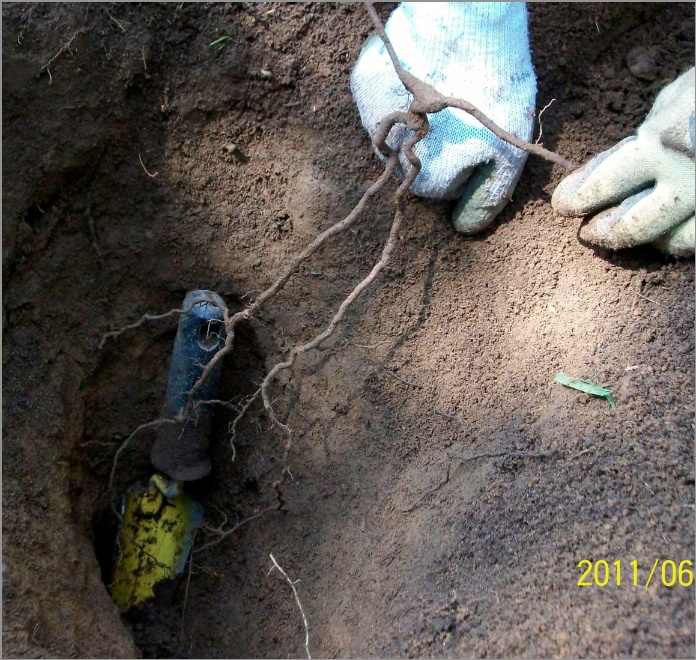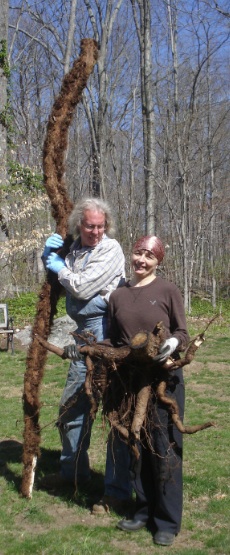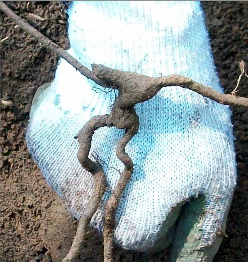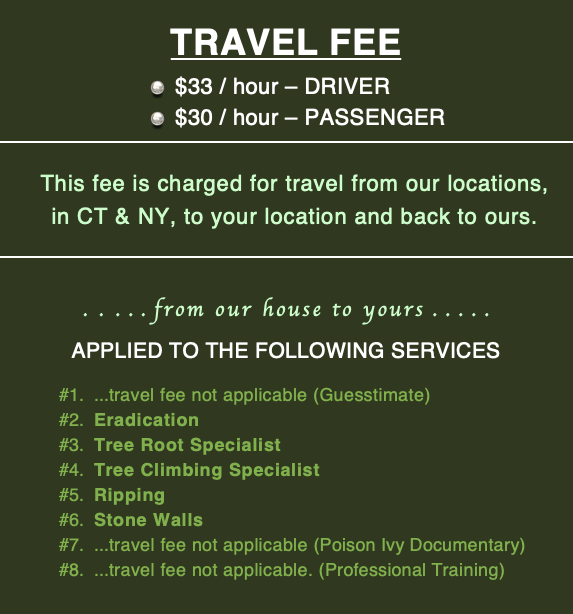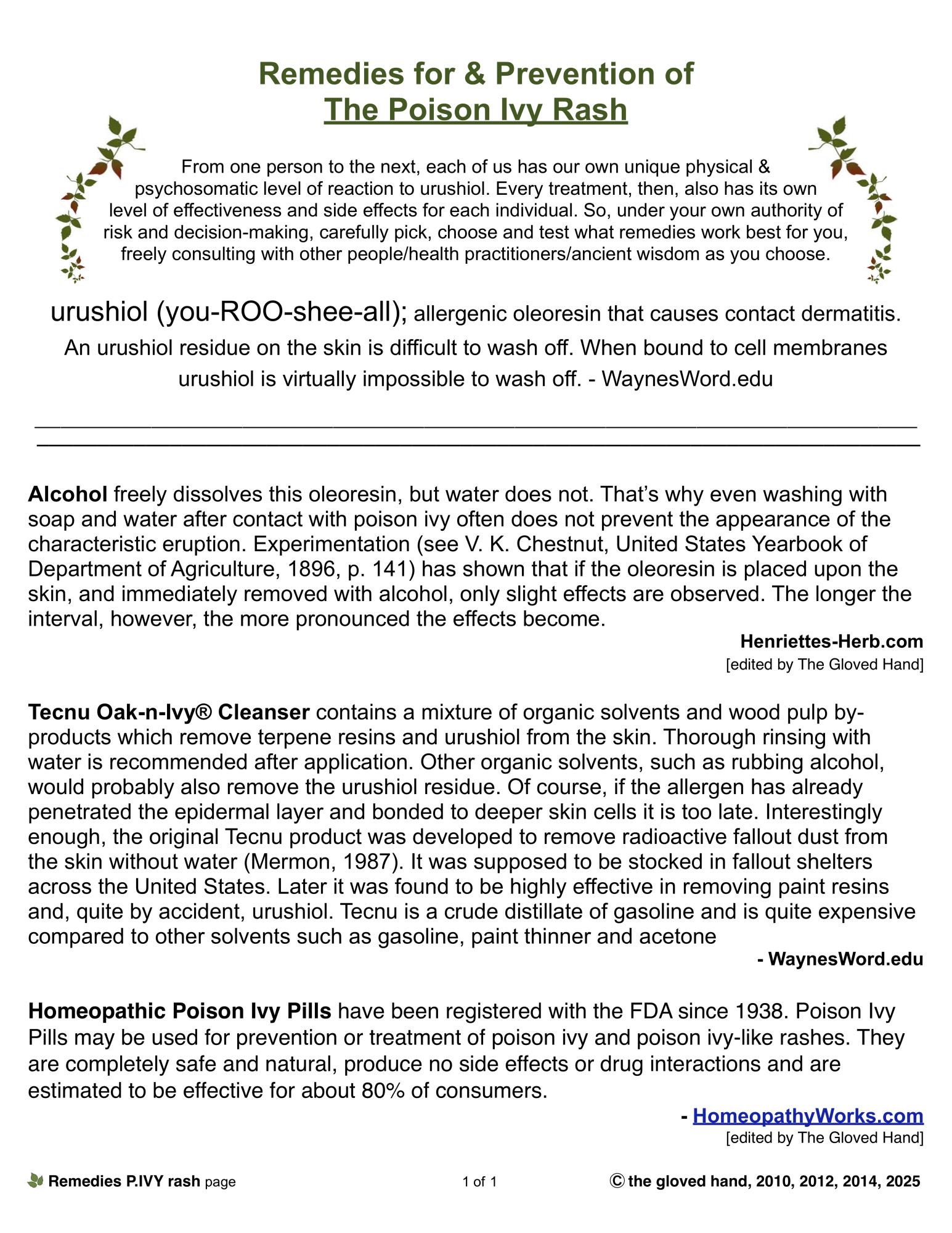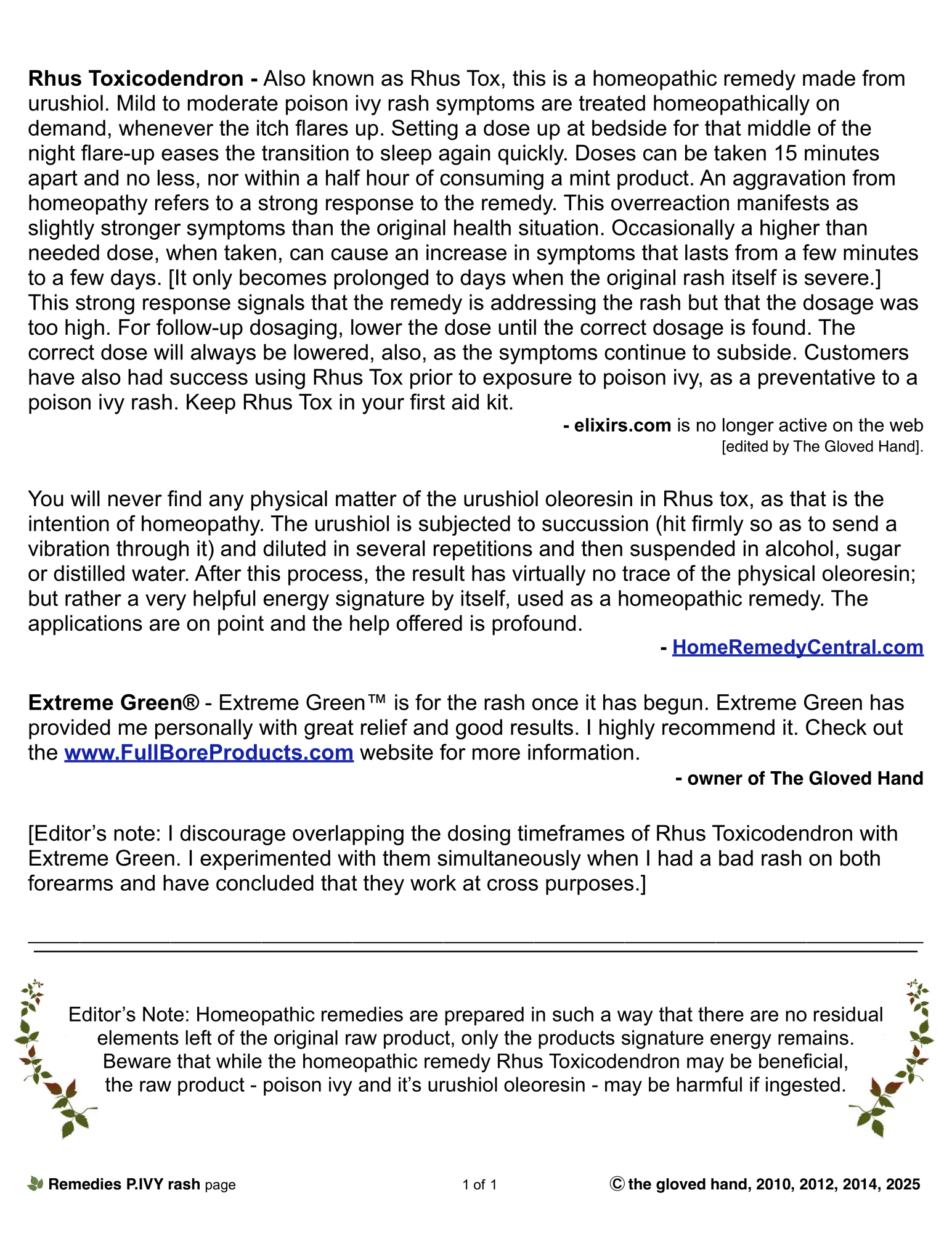Pictured below is William Bartlett, my Tree Specialist Eradicator. For the largest tree-climbing vines he uses a come-a-long to bring them down. He will also climb up a tree when he has to. He's tackled to the ground some thick, record-breaking vines. I'm posing with a large base of poison ivy roots that he pulled out for me. He's been in the business for over 40 years.
Same tuber: if you look closely enough, this picture below (click to enlarge) shows how skinny the long roots will become the deeper we explore.
-
_____________________
_________________
You can see from the second photo that this root was dug out of a deep hole. When we measured the hole and the root itself, they both measured nearly two feet. Poison ivy, in its undisturbed state, normally runs less than an inch under the earth's surface and fairly parallel to the ground. Any secondary roots growing off of a typical runner are only 4 or 5 inches in length and grow at an acute angle to the runner. Abberant roots like the one pictured are found to grow vertically, perpendicular to the earth's surface. When we start chasing a root that goes straight down like this, I feel that 8" is an adequate depth for digging the root out. Once past 8", a root often is too skinny for survival on it's own, especially at such a depth.
_________________________
A poison ivy root tuber: at the top left corner of this tuber you can see the original cut (click to enlarge), causing this tuber to develop in the first place.
1. Guesstimate - The root system is the mystery, which is why it's a "guesstimate" and not an estimate. I usually won't need to go to the property because what you can see above ground is what I would see. There are indicators above ground that you can describe over the phone to me. [203-736-0664] Answering the questions I ask will help me determine what difficulties the root system will present, once we dig in. In this way I can help you with a 'ball-park" cost.
– Geoff has been working with The Gloved Hand since 2011 –
+
– Ellen has been working with The Gloved Hand since 2018 –
+
– Gabi has been working with The Gloved Hand since 2019 –
Hello there. My name is Cindy. It is 2025 and I became involved with the poison ivy plant in 1988 when my husband and I bought a house (in Connecticut) with poison ivy on the premises.
My husband had previously contracted a particularly severe case of the poison ivy rash which had required medical treatment, so I proceeded to clear out our new yard by myself. I found that the most comfortable method for me was to remove the entire root system by hand. The results were good, too. While under the tutelage of a knowledgeable Yankee farmer I learned techniques regarding weather conditions and seasonal changes that make for the most productive weeding. Now I am able to identify poison ivy in the dormant season when there are no leaves, just the buds on the plant; I can eradicate poison ivy before the season begins! I recommend keeping this in mind when hiring The Gloved Hand. As soon as the ground thaws in March, it is possible to get started. (May and June are very busy.) Work continues on through spring, summer and again, autumn is also an excellent time for poison ivy eradication, until the temperature starts falling below 50º.
After helping my husband out on our own property I began helping other relatives as well; and next, it was my neighbors calling. My business officially started for the public in 2009. When I advertised on the internet in 2011 things started in earnest. It has been a delightful journey.
Contrary to what you might think, I am not one of those rare individuals who is blessed with a natural immunity to the plant. Armed with tenacity however, I have developed protocols for my personal protection and have trained others to do the same.
Poison Ivy Documentary
For specific information on...
P. Ivy Identification:
8 minutes + 30 seconds into video
sdfg
P. Ivy Look-A-Likes:
21 min + 15 sec
asdf
Techniques for Digging it out:
25 min + 50 sec
asdf
Dressing & Undressing Safely:
40 min + 15 sec
Watching this video is a cornerstone to participating in The Gloved Hand training.
9. Professional Training - A one-to-one training for an individual to become a sub-contractor for "The Gloved Hand." This training is divided into two sessions, each one on a separate day. Time will be spent handling and working with the poison ivy plant each day (wearing gloves!).
Watching the Poison Ivy Documentary is a pre-requistie to this training.
$858 in barter/person includes the two days. At the conclusion of the "Poison Ivy Eradication and Protection Protocol Training" start working for The Gloved Hand at $30, quickly rising to $33 and with sincere progress, to $36, with even higher rates for those who develop further through the company.
– two 3 to 4 hour sessions –
See box below for more information:
– FREE –
DIY-ers: work at your own risk. Throughout your work, please be conscious of what becomes contaminated with urushiol.
Share this video with people interested in subcontracting with The Gloved Hand. If you become interested, please check out the Professional Training information below the video.
$81/hour: Lead Eradicator
$72/hour: 2nd Eradicator
Hauling Fees: $15 per large bag
– 4 hr minimum –
(pro-rated by the minute after 4 hrs)
7. Stone Walls - eradicating the roots from out, under and in-between stones in walls sometimes calls for relocating stones and putting them back or, considering the situation, moving the stone wall laterally by some number of feet.
$66/hour: Lead Eradicator
$60/hour: 2nd Eradicator
Hauling Fees: $15 per large bag
– 4 hr minimum –
(pro-rated by the minute after 4 hrs)
6. Ripping - Ripping out poison ivy without the use of tools. By hand, pulling out as much of the root as possible. This is not a coomplete eradication since some roots may still remain in the ground. This quicker method is for clearing out a larger area of poison ivy in a shorter period of time. A 2nd visit is recommended to dig out all the roots.
5. Tree Climbing Specialist -
A worker who climbs a tree to remove the vines that cannot be taken down from standing on the ground or on a ladder. This tree specialist can also remove the most humongous of vines that literally cannot be pulled off by human strength alone but require a winch on the back of a pickup truck.
4. Tree Root Specialist - Where an old poison ivy climber has developed over many years, its particularly thick main roots are dug out (2-inch diameter or thicker) around the base of a tree and the climber is pulled off the tree as high as can be done with the assistance of a ladder.
$66/hour: Lead Eradicator
$60/hour: 2nd Eradicator
Hauling Fees: $15 per large bag
– 4 hr minimum –
(pro-rated by the minute after 4 hrs)
2. Eradication - Eradicating poison ivy roots, runners and climbers (climbers under 2-inch in diameter) by digging the plant's entire root system out using a double set of gloves with hand tools and pulling poison ivy vines off trees.
8. Poison Ivy Documentary -On YouTub
See below: an hour-long Poison Ivy Documentary for Do-It-Yourselfers. This video includes the best poison ivy identification lesson on the web and a Protection Protocol for Do-It-Yourselfers!
OVER THE PHONE – No Cost.
203-736-0664 or email me your # and I will contact you.
If there is some reason to visit the site: UNDER 2.5 ACRES -
"Search & Assess" fee is double the travel fee ($45 minimum) + the travel fee.
2.5 ACRES & OVER - "Search & Assess" fee is $45 per hour + the travel fee.
The cost of this "Search & Assess"
visit is NOT deducted from the actual job. This is a separate cost.
$96/hour: Tree Climbing Specialist
Specialist Hauling Fees: $500/level dump truck or $125/cubic yard, for example: 2" diameter vine at 50' in height may cost around $50 in hauling, however, distance to dumping site and other circumstances will vary the price.
– 4 hr minimum –
$81/hour: Tree Root Specialist
$72/hour: 2nd Tree Root Specialist
Hauling Fees: $15 per large bag
– 4 hr minimum –
(pro-rated by the minute after 4 hrs)
William Bartlett, Cindy, and a tree-climbing poison ivy vine with its' roots detached. (click to enlarge)
______________________
3. Digging Crew - Where the infestation of poison ivy has become so dense that digging out the infestation with shovels as a 'once-over' is more efficient, followed by detailed eradication (see #2) of any grow-back.
$81/hour: Dig Crew Specialist
$72/hour: Additional Dig Crew
Hauling Fees: $15 per large bag
– 4 hr minimum –
(pro-rated by the minute after 4 hrs)
________________________________
When I visit a poison ivy patch, I often dig up some rather interesting-looking roots. The way I explain the first one pictured below is this: when poison ivy roots are cut or ripped (you can see the cut in the first of the two photos), the sources of energy that would have normally flown through the runner, past that previously cut spot, have now bumped into a dead end. The energy collects and stores in that dead end by filling out into a root tuber. From that tuber (or rhizome), 4 or 5 roots may start out in multiple directions but also a tap-like root may begin to grow straight down, as a means to support survival of the plant under its newly threatened circumstances (of having been cut).
Therefore, ripping or trimming roots just down to the ground level (not digging them out) causes the root system to "bush out" underground. This is a similar process to when one trims a bush above ground in order for it to fill out and become more bushy. This is not something I recommend, that poison ivy roots be ripped out, mowed or otherwise cut at the ground level every year and maintained this way year-in and year-out. It creates a HUGE root system and eventually a greater magnitude to the job when finally digging the entire root system out.
PROFESSIONAL TRAINING IS PAID FOR BY SUBCONTRACTING FOR THE GLOVED HAND:
TRAINING IS DONE DURING the HUB SEASONS: MARCH - APRIL and SEPT. 15 - NOV. 15. Ask for exceptions.
At the conclusion of the Professional Training and in a bartered arrangement for this training, begin working for The Gloved Hand at $30 per hour, with $6 deducted from your pay for each hour worked. (Hence, 30-6=24 with $24/hr being your take home pay.) Quickly rise to $33/hr once the Protection Protocol has been consistently implemented on the job. The pay increases to $36 once a worker is able to determine the best approach to a poison ivy patch, while working with a supervisor. During this ongoing work, with the $6/hour automatic deductions made towards paying off the Professional Training cost, it will take 143 hours of working for The Gloved Hand (approximately during your first 28 days of work) to reach the total reimbursement value of $858 due The Gloved Hand for the Organic Poison Ivy Eradiation & Protection Protocol professional training.
